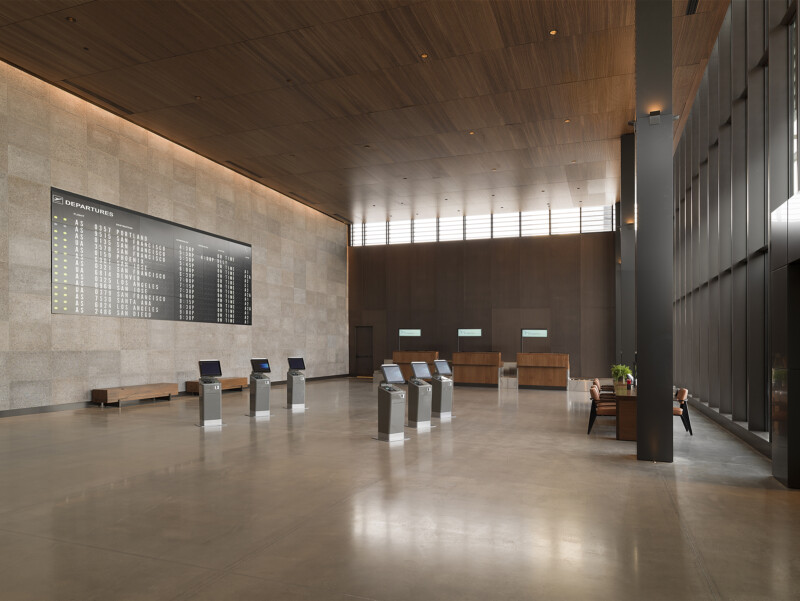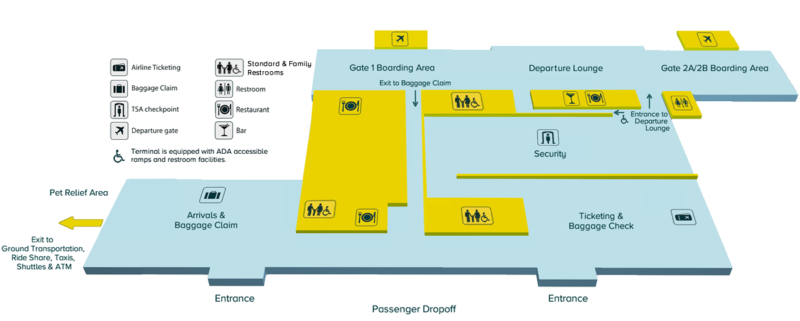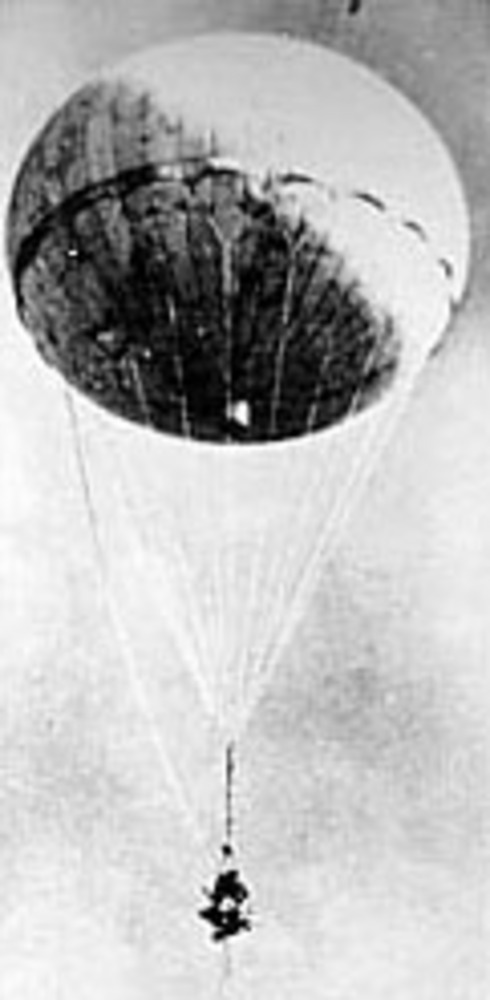
Paine Field Terminal, 3300 100th Street SW, on Google Maps
Eight miles south of downtown Everett and less than 10 minutes off north-south Interstate 5, Paine Field serves the North Puget Sound region of Washington state. It is the closest airport to Seattle’s northern neighborhoods and cities. Downtown Seattle is about a half-hour away. Paine Field has gained acclaim for its airline passenger terminal that combines modern design and technology with a small airport customer focus allowing passengers to get to and from their flights quickly and in a low-stress environment. Opened in 2019, you could say the terminal was 80 years in the making.
Ground transportation options at the terminal include taxis, app-based ride services Uber and Lyft and shuttles. Car rental companies Avis and Budget provide shuttles from the terminal to their nearby locations. Public transportation is available on Everett Transit Route 8, which serves the airport with a stop at the terminal.


What took so long for the airport to get its first passenger terminal? Originally conceived as one of 10 “super airports” the United States government would build to spur on the economy during the Great Depression, the Works Progress Administration began construction at the “fog free” site in 1936 but before it could be finished, the Army Air Corps arrived in 1939 and a year later took over the field as World War II was escalating. The Army named the airfield for one of its earliest aviators Lt. Topliff O. Paine, who grew up in Everett.
After the war, during the process of turning the airport over to Snohomish County, the Korean War brought the military back and in 1951 the airfield became Paine Air Force Base.
Then in 1966, as the military was once again preparing to vacate the airfield, the Boeing Company announced it had selected a site adjacent to Paine Field to build the world’s largest commercial airliners, the Boeing 747. Both the Federal Aviation Administration (FAA) and Snohomish County liked the idea and agreed to it. The first 747 was rolled out in 1968, the same year the Air Force officially closed its operations on the airfield. After that the airport was used for general aviation and Boeing’s manufacturing operations.
Talk of bringing commercial airline service to Paine Field surfaced in 1989 but didn’t gain momentum for another 15 years. The City of Everett supported the idea but Snohomish County, which owns the airport, was content restricting use to manufacturing and private aircraft. Despite requests from airlines, the county resolved it would not spend money to develop Paine Field as a commercial airport. By taking that stance, the FAA determined in 2012 the county was creating a restriction that would no longer qualify it to receive federal funds to operate a public use airport.
Enter Propeller Airports, which in 2014 proposed creating a public-private partnership with the county to build and operate a commercial airline terminal at Paine Field. Propeller Airports, a subsidiary of private equity firm Propeller Investments, and county officials agreed to the proposal, which then prompted lawsuits in opposition to allowing commercial flights. That resulted in a 2016 ruling by the Ninth U.S. Circuit Court of Appeals in favor of commercial service. Construction started in 2017 and the $40 million Passenger Terminal at Paine Field served its first passengers on March 4, 2019.

Described as a boutique facility, the three-gate 30,000-square-foot terminal is designed to be customer-centric, allowing passengers to move through it quickly but in a tranquil environment. The airline check-in lobby is reminiscent of an upscale hotel lobby. Gate areas have a “living room” feel that includes two fireplaces.
A café run by Seattle artisanal cheesemaker Beecher’s and a bar featuring wines and other locally sourced offerings of the Pacific Northwest are located in the departures area.
Alaska Airlines flights arrive and depart the Paine Field Passenger Terminal using any one of its three gates, Gate 1 and Gates 2A and 2B. Passengers who are making connections on to other Alaska Airlines flights can do so without leaving the TSA secure area provided baggage has been checked to the final destination.
On Port Gardner Peninsula at the mouth of the Snohomish River, Everett is a hub for recreational activities from skiing in the winter to water sports in the summer. The nearest ski resort is just over an hour away and the Port of Everett Marina, with almost 2,200 slips, is the largest public marina on the U.S. West Coast. The Everett waterfront is also the headquarters of Naval Station Everett. Thanks to Boeing, the area is a center for aviation enthusiasts. Take the company’s tour and you can say you have been inside the world’s largest building with 4.28 million square feet of floor space and containing 472 million cubic feet by volume, it takes up more than 98 acres.
Get ideas for exploring Seattle NorthCountry at the Snohomish County Tourism Bureau.
 On March 13, 1945 a hydrogen-filled balloon measuring about 70-feet tall and 33-feet in diameter landed about one-fourth of a mile west of what is now the intersection of Glenwood Avenue and Merrill Creek Parkway in Everett. An Army disposal unit quickly – and quietly – took it to Paine Field where they found it had been rigged with anti-personnel and incendiary explosives. Years later it was learned 15 other balloon bombs had landed the same day in places from Alaska to California. It was the most that had landed in one day. At the time, the Army kept a tight lid on information about the devices, much to the consternation of Japanese military officials awaiting news of disruptions. After the war it was revealed that more than 9,000 of the balloons, called a Fu-Go or fire balloon, had been launched between November 1944 and April 1945 from a beach on Honshu Island in Japan and carried by jet stream across the Pacific usually in three to four days. About 280 made landfall and were recovered. For the most part they caused little damage, except for an incident on May 5, 1945, when five children and a pregnant woman were killed after they found one while on a church picnic in Oregon.
On March 13, 1945 a hydrogen-filled balloon measuring about 70-feet tall and 33-feet in diameter landed about one-fourth of a mile west of what is now the intersection of Glenwood Avenue and Merrill Creek Parkway in Everett. An Army disposal unit quickly – and quietly – took it to Paine Field where they found it had been rigged with anti-personnel and incendiary explosives. Years later it was learned 15 other balloon bombs had landed the same day in places from Alaska to California. It was the most that had landed in one day. At the time, the Army kept a tight lid on information about the devices, much to the consternation of Japanese military officials awaiting news of disruptions. After the war it was revealed that more than 9,000 of the balloons, called a Fu-Go or fire balloon, had been launched between November 1944 and April 1945 from a beach on Honshu Island in Japan and carried by jet stream across the Pacific usually in three to four days. About 280 made landfall and were recovered. For the most part they caused little damage, except for an incident on May 5, 1945, when five children and a pregnant woman were killed after they found one while on a church picnic in Oregon.
Be among the first to know and get regular updates about Tucson International Airport from the Tucson Airport Authority in our monthly newsletter.